The Cell Cytoplasm
- teachanatomy

- Jun 28
- 11 min read
The cytoplasm occupies the space between the nucleus and the cell membrane. It usually stains acidophilic. It has three components: the matrix, cytoplasmic organelles and cytoplasmic inclusions. The cytoplasmic matrix (cytosol or ground substance) is amorphous. It contains electrolytes, enzymes and metabolites, and exhibits sol-gel properties. Cytoplasmic inclusions are non-living; they are stored nutrients, secretory product or pigment granules. Cytoplasmic organelles are small living structures; some of them can be seen by the light microscope (LM); others can only be seen by the electron microscope (EM). Some are membrane bound; others are not. They perform specific functions; They include:
Ribosomes
Rough endoplasmic reticulum (rER)
Golgi apparatus
Lysosomes
Smooth endoplasmic reticulum (sER)
Mitochondria
Microtubules
Filaments
Centrioles
Cilia
Peroxisomes
Organelles are categorized into membranous and non-membranous organelles. Membranous organelles include rough endoplasmic reticulum, Golgi apparatus, lysosomes, smooth endoplasmic reticulum, and mitochondria. Non-membranous organelles include ribosomes and centrioles.

Cytoplasmic Organelles
Ribosomes and Polysomes
Ribosomes are small organelles that can only be seen with the electron microscope (EM), where they appear as dark tiny particles (about 20nm). Ribosomes are made of ribonucleic acid (RNA) and protein. They are sites for protein synthesis, namely, site for mRNA translation. They read the genetic information coded on mRNA (messenger RNA) and accordingly build a string of amino acids to form a specific protein molecule. Ribosomes are present in the cytoplasm in two forms: free ribosomes or ribosomes attached to the rough endoplasmic reticulum (rER). Free ribosomes are present either as solitary ribosomes or as small groups of ribosomes called polysomes. Each ribosome has two subunits: a small subunit and a large one. Free ribosomes (not associated with rER) synthesize protein for use inside the cell itself (cytoplasmic proteins). Since ribosomes contain acid (rRNA), a cytoplasm rich in ribosomes stains basophilic.

Rough Endoplasmic Reticulum (RER)
Rough endoplasmic reticulum (RER) is a membranous cytoplasmic organelle. It consists of sacs called cisternae. This organelle cannot be seen with the light microscope; it can be seen only with the electron microscope. RER membranous cisterns are studded with ribosomes; thus, a cytoplasm rich in RER is basophilic. RER functions in synthesis of secretory protein, integral plasma membrane proteins and lysosomal enzymes. Protein synthesized in RER is carried to Golgi apparatus via small vesicles called transfer vesicles. RER is well developed in cells which secrete large amounts of proteins such as plasma cells which secrete immunoglobulins; the cytoplasm of plasma cells is fully packed with cisternae of RER.

Golgi Apparatus (Complex)
Golgi apparatus is membranous organelles. It is one of the few organelles that can be depicted with the light microscope, but only in sections stained by special methods such as the silver staining methods; it cannot be seen in H&E sections. Nevertheless, in cells which are highly basophilic such as plasma cells, the area occupied by Golgi appears pale. This pale area constitutes what is known as the Golgi negative image.

1. Under the electron microscope the Golgi apparatus appears as a stack of membranous sacs. These sacs are known as Golgi saccules. Several vesicles and tubules are associated with the Golgi saccules. All Golgi elements (saccules, vesicles and tubules) are devoid of ribosomes, and thus do not stain basophilic in route histology sections. The stack of Golgi saccules is often curved. The convex surface of stack is called immature (forming) face, whereas the concave one is called maturing face of Golgi apparatus. Golgi apparatus is sometimes referred to as the Golgi body or the Golgi complex. Golgi apparatus is not a static organelle; it is all the time gaining and losing elements. New saccules are formed at the immature (cis) face by merging of transfer vesicles. The newly formed saccules dip into the complex and gradually move towards the mature (trans) face, where they lost. Meanwhile, the saccule contents become more concentrated. The Golgi apparatus has several functions which include:
1. Packaging secretory proteins and lysosomal enzymes.
2. Modification of proteins.
3. Conjugation of lipid and carbohydrates.

Lysosomes
Lysosomes are membranous organelles containing hydrolytic enzymes. They contain more than fifty different acid hydrolases capable breaking down all sorts of organic matter, including proteins, lips nucleic acids and carbohydrates. Lysosomes shapes: different shapes; some are spherical, others are oval or irregular. Some of are quite electron dense, appearing uniformly dark other are uniformly moderately electron dense and have heterogenous contents. Lysosomes are of different types, which include primary lysosomes, secondary lysosomes, tertiary lysosomes and residual bodies. Lysosomes can be seen by both EM and LM. By LM they need special staining techniques to be visualized. Lysosomes are a characteristic feature of phagocytic cells such as neutrophils and macrophages. Such cells contain large numbers of different types of lysosomes.
Primary lysosomes are produced by the Golgi apparatus. They enzymes are synthesized within RER and packaged by Golgi. Primary lysosomes appear under the transmission electron microscope as moderately dense spherical bodies. They are packages of hydrolytic enzymes that can digest organic matter. They fuse with foreign engulfed organisms, organic matter and degenerate own cytoplasmic organelles, forming secondary lysosomes. Secondary lysosomes have different sizes and a heterogenous content. The process of digestion ends by forming tertiary lysosomes which are dense bodies called residual bodies. Residual bodies may be conjugated with lipids forming lipofuscin granules which are usually numerous in neurons of old people. Lysosomal storage diseases are inborn diseases associated with malfunctioning of lysosomes. They cause accumulation of substrates (lipoproteins, mucolipids, mucopolysaccharides. oligosaccharides) in cells of some organs causing ill functioning of those organs.
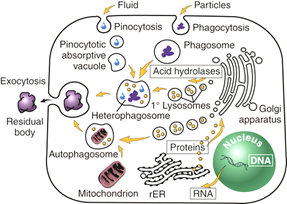
Protein Synthesis
Proteins are large complex molecules made up of amino acids. They are key players in the normal functioning of the human body and its tissues and cells providing building blocks and acting as hormones and enzymes. They are required for preserving the structure and function of tissues and organs of the body. Proteins synthesis is needed for making new building blocks and for replacement of proteins lost due to degradation and degeneration. It is evident then that protein synthesis is a crucially important biological process. The process has two phases: transcription and translation. Transcription takes place within the nucleus. It is a process of copying the code (gene) present in a segment of the DNA strand into a strand messenger RNA (mRNA). The process of copying is carried out by enzymes known as RNA polymerases. The mRNA strand leaves nucleus via the nuclear pores into the cytoplasm. Translation is the process whereby peptide chains are made by ribosomes in accordance with information encoded in the mRNA strand. Amino acids are brought into the location where a ribosome is attached to the mRNA strand to be conjoined in the sequence dictated by mRNA forming a specific peptide chain. Peptide chains formed by polyribosomes (polysomes) remain free in the cytoplasm, whereas those produced by ribosomes attached to rER cisterns pass into the lumen of cisterns isolated from the rest of the cytoplasm. They could enzymes, hormones, hydrolases. They carried from rER to Golgi complex to packed into secretory vesicles or primary lysosomes. Secretory vesicles pass towards the cell plasma membrane to be secreted by exocytosis (merocrine secretion).

Smooth Endoplasmic Reticulum (SER)
Smooth endoplasmic reticulum (sER) is also a membranous organelle. It cannot be seen by the light microscope; It can only be seen with the electron microscope. sER consists of interconnected short branching tubules and vesicles. There are no ribosomes associated to sER; sER is devoid of ribosomes. The main functions of sER are
1. Detoxification of noxious substances and drugs
2. Synthesis of steroid hormones
3. Lipid and glycogen metabolism
4. Transport of Ca++
sER is abundant in liver cells (detoxification), adrenal cortex cells (steroid hormone synthesis) and muscle fibers (Ca++ transport).

Mitochondria
Mitochondria are membranous cytoplasmic organelles. They are clearly visible under the electron microscope and can also be seen with the light microscope using special staining techniques. Mitochondria are tiny sausage-like structures of variable length and thickness, 0.5-3 um. Electron microscopy shows that each mitochondrion is surrounded by two membranes; the outer membrane is smooth, whereas the inner one is folded forming shelf like structures known as cristae or ridges. The lumen of the mitochondrion is occupied by the mitochondrial matrix, which contains enzymes for oxidative phosphorylation, DNA strands, RNA strands, ribosomes and matrix granules. Matrix granules are thought to regulate ions and supply components of the inner mitochondrial membrane. The space between the outer and inner mitochondrial membranes is called the intermembranous space. Mitochondria reproduce by binary division.

Mitochondria are present in all body cells except RBCs and dead keratinocytes. They are responsible for energy production. Thus, they are present in large numbers in cells that generate and utilize large amounts of energy such heart muscle cells and neurons. Mitochondria constitute up to 40% of the volume of cardiac muscle cells. Mitochondria contain Krebs cycle and phosphorylation enzymes (for cell respiration and ATP production). Enzymes for oxidative phosphorylation are present on membranes of mitochondrial cristae whereas Krebs cycle enzymes are present in the mitochondrial matrix, along with mitochondrial DNA, RNA. Mitochondria also play a significant role in apoptosis (programmed cell death). Mitochondrial DNA (mtDNA) is less protected than nuclear DNA from the surrounding environment, and accordingly mtDNA is more prone to mutation. Several diseases are related to mutations in the mitochondrial DNA. These are known as mitochondrial diseases. Everybody gets his/her mitochondria from the mother (from the oocyte), so mtDNA is passed down from the mother to children.

Microtubules and Filament
Microtubules are tiny hollow cylindrical structures that can only be seen with the electron microscope. They are about 25nm in diameter but comparatively long, reaching about 15um in length. Occasional, microtubules are present in groups, in such situations they can be seen with the light microscope using special methods. Microtubules contribute to formation of cilia, centrioles, the mitotic spindle and the cytoskeleton. Microtubules function in cell motility, intra-cytoplasmic transport of organelles & chromosomes (mitosis). They are polymers of tubulin subunits. These subunits join each other end to end forming new microtubules or increase the length of already existing microtubules. Microtubules can dismantle causing shortening of microtubules or their disappearance. The filaments are thinner than microtubules but are solid thread-like structures. There are different types of filaments. These include actin and myosin filaments present in muscle cells. Cell contraction depends on actin and myosin filaments. Filaments also include intermediate filaments such as keratin and vimentin which are present in both the cytoplasm and nucleoplasm giving shape and support to the nucleus and the cell itself. Intermediate filaments also include neurofilaments of neurons and spectrin of blood cells. Intermediate filaments are generally supportive.

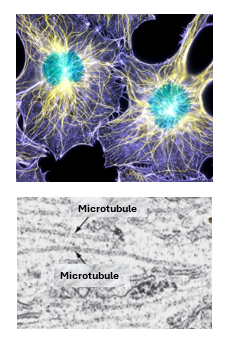
Centrioles
Centrioles are a pair of cylindrical structures oriented perpendicular to each other seen in non-dividing cells (cells not undergoing cells division). The pair occupies a region close to the nucleus called the centrosome. The centrosome can be seen by the light microscope and the centrioles can be seen with electron microscope. Centrioles control formation and disintegration of microtubules. As thus, they participated in the formation of the mitotic spindle, movement of chromosomes, change of cell shape cell motility and cell division. Each centriole is a short cylinder having a wall made of 9 triplets of microtubules. Of the triplet microtubules, the one in the middle is complete and the other two are incomplete.
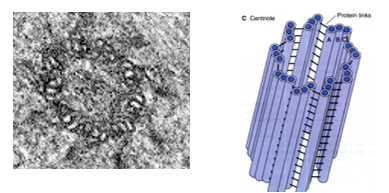
Cilia
Cilia are motile organelles that project from the cell surface covered by the cell membrane. Many cilia can be seen on the surface of certain cells e.g. epithelial cells of the trachea. Cilia are characterized by what is known as the 9+2 pattern (9 peripheral microtubule doublets and 2 central singlet microtubules). Cilia have basal bodies that resemble centrioles (9 triplets). Cilia are a characteristic feature of epithelial cells of the respiratory passages and parts of the female genital tract. In the respiratory passages they participate in the formation of the muciliary apparatus which plats a significant role in defending the body against airborne organisms and particles. In genital tracts cilia play a significant role in propulsion of ova and zygotes.

Cytoplasmic Inclusions
These are non-living structures seen in the cytoplasm of eukaryotic cells. The inclusions include stored food, pigments and crystals. Stored food includes glycogen and fat. Glycogen particles can be seen with light microscope after special stain (Best’s carmine staining method) in liver cells and muscle fibers. Lipid droplets are present in many cells (liver, adrenal cells. They can be seen by special stains (e.g. OsO4). Pigments include melanin (in the skin and eye for instance) and hemoglobin (RBCs). Pigments have natural colour. Crystals are made of protein. They have regular shape. They may be seen free in the cytoplasm (Leydig cells of testis) or within granules (eosinophils).


Cytoplasmic Matrix
Cytoplasmic matrix is the ground substance of the cytoplasm; it is also called cytosol. It has no visible structure. It contains metabolites and electrolytes, as well as synthesized proteins and enzymes. The cytoskeleton is embedded in the matrix. The cytoskeleton is made of networks of microtrabeculae where most cytoplasmic organelles are kept anchored.
Cell membrane
The cell membrane acts as a barrier between the cell and its environment. It has a trilaminar (3-layer) appearance under EM (2 dense layers and a light layer in-between) made of phospholipids, cholesterol and protein. The two dense layers are primarily made of lipids (phospholipids, fatty acid chains and cholesterol
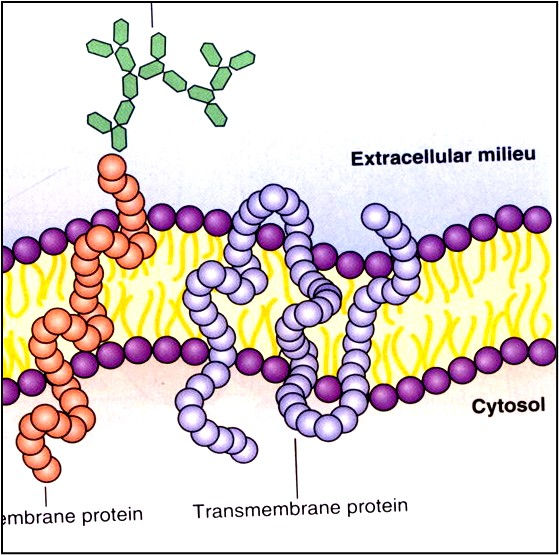
The cell membrane proteins include integral proteins and peripheral proteins. Integral proteins have important functions. They act as receptors (e.g. for hormones), ion channels and pumps (e.g. for Na+), transducers (coupling receptors with cytoplasmic enzymes).
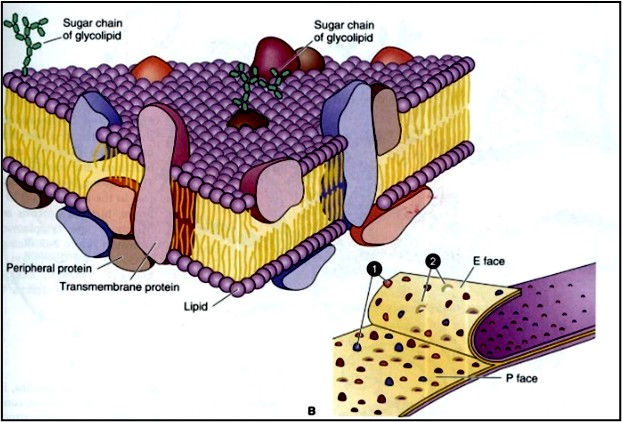
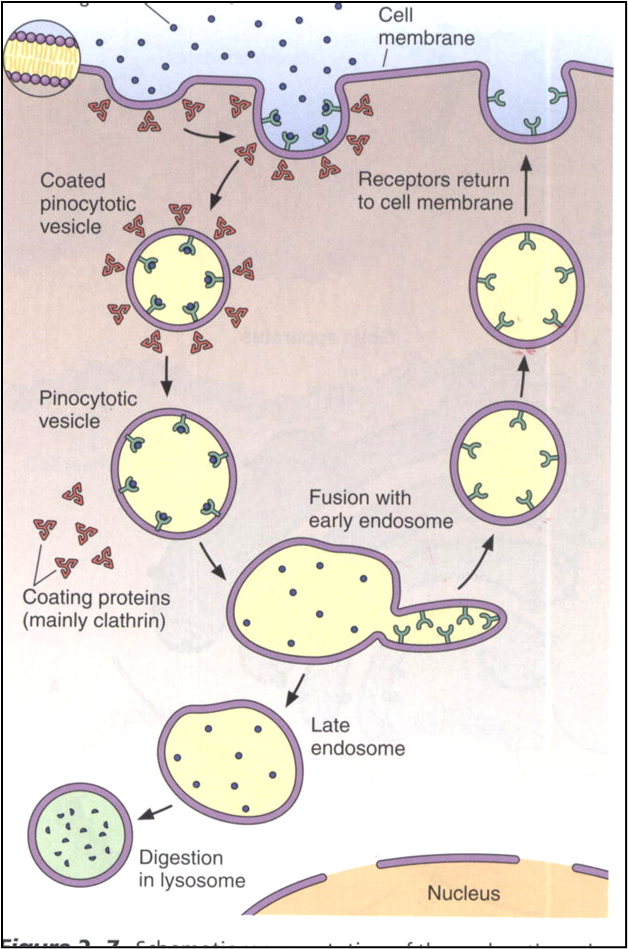




Comments